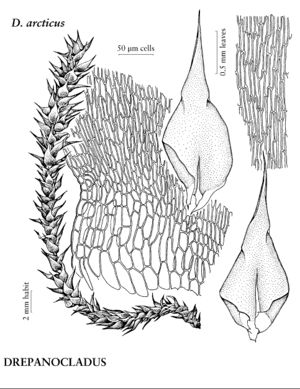Difference between revisions of "Drepanocladus arcticus"
Bryologist 100: 82. 1997.
FNA>Volume Importer |
FNA>Volume Importer |
||
| Line 18: | Line 18: | ||
|name=Campylium arcticum | |name=Campylium arcticum | ||
|authority=(R. S. Williams) Brotherus | |authority=(R. S. Williams) Brotherus | ||
| − | }}{{Treatment/ID/Synonym | + | }} {{Treatment/ID/Synonym |
|name=C. stellatum var. arcticum | |name=C. stellatum var. arcticum | ||
|authority=(R. S. Williams) L. I. Savicz | |authority=(R. S. Williams) L. I. Savicz | ||
| Line 35: | Line 35: | ||
|elevation=low elevations | |elevation=low elevations | ||
|distribution=Greenland;N.W.T.;Nunavut;Alaska;Eurasia. | |distribution=Greenland;N.W.T.;Nunavut;Alaska;Eurasia. | ||
| − | |discussion=<p>Drepanocladus arcticus has frequently been confused with Campylium stellatum and D. polygamus, as all occur in Arctic areas. Amblystegium chrysophyllum var. zemliae C. E. O. Jensen [Campylium zemliae (C. E. O. Jensen) C. E. O. Jensen] may be an older name for D. arcticus; however, because no type material of this taxon seems to be extant, and the protologue does not allow certain conclusions regarding its identity, this cannot be decided. Two duplicate specimens from the Jensen herbarium originally identified as C. zemliae (Uummannaq, Vahl s.n., July 1834 [H, S]) belong to D. polygamus. The leaf acumina are (1–)1.2–2.3 times the basal leaf length.</p> | + | |discussion=<p><i>Drepanocladus arcticus</i> has frequently been confused with <i>Campylium stellatum</i> and <i>D. polygamus</i>, as all occur in Arctic areas. <i>Amblystegium</i> chrysophyllum var. zemliae C. E. O. Jensen [<i>Campylium</i> zemliae (C. E. O. Jensen) C. E. O. Jensen] may be an older name for <i>D. arcticus</i>; however, because no type material of this taxon seems to be extant, and the protologue does not allow certain conclusions regarding its identity, this cannot be decided. Two duplicate specimens from the Jensen herbarium originally identified as C. zemliae (Uummannaq, Vahl s.n., July 1834 [H, S]) belong to <i>D. polygamus</i>. The leaf acumina are (1–)1.2–2.3 times the basal leaf length.</p> |
|tables= | |tables= | ||
|references={{Treatment/Reference | |references={{Treatment/Reference | ||
| Line 61: | Line 61: | ||
|publication year=1997 | |publication year=1997 | ||
|special status=Selected by author to be illustrated | |special status=Selected by author to be illustrated | ||
| − | |source xml=https://jpend@bitbucket.org/aafc-mbb/fna-data-curation.git/src/ | + | |source xml=https://jpend@bitbucket.org/aafc-mbb/fna-data-curation.git/src/8f726806613d60c220dc4493de13607dd3150896/coarse_grained_fna_xml/V28/V28_459.xml |
|genus=Drepanocladus | |genus=Drepanocladus | ||
|species=Drepanocladus arcticus | |species=Drepanocladus arcticus | ||
Revision as of 17:05, 18 September 2019
Plants medium-sized to large. Stems irregularly and often sparsely branched. Stem leaves patent, spreading, or squarrose, ovate, broadly ovate, or triangular-ovate, suddenly or gradually narrowed to apex, concave or strongly concave, (1–)1.7–3.6 × 0.6–1.5 mm; base erect, subclasping, insertion usually deeply U-shaped; margins entire, or sometimes slightly sinuate near apex; apex acuminate, acumen usually sharply differentiated, furrowed or strongly furrowed; costa double and short, very rarely single and ending well before mid leaf; alar region transversely triangular, reaching from margin 66–100% distance to costa; ratio of medial laminal cell length (µm) to leaf length (mm) 26–30.2. Sexual condition autoicous.
Habitat: Coastal areas in Arctic, lagoons, salt water pools, shore meadows, fens, bird cliffs, mineral-and more or less nutrient-rich habitats
Elevation: low elevations
Distribution

Greenland, N.W.T., Nunavut, Alaska, Eurasia.
Discussion
Drepanocladus arcticus has frequently been confused with Campylium stellatum and D. polygamus, as all occur in Arctic areas. Amblystegium chrysophyllum var. zemliae C. E. O. Jensen [Campylium zemliae (C. E. O. Jensen) C. E. O. Jensen] may be an older name for D. arcticus; however, because no type material of this taxon seems to be extant, and the protologue does not allow certain conclusions regarding its identity, this cannot be decided. Two duplicate specimens from the Jensen herbarium originally identified as C. zemliae (Uummannaq, Vahl s.n., July 1834 [H, S]) belong to D. polygamus. The leaf acumina are (1–)1.2–2.3 times the basal leaf length.
